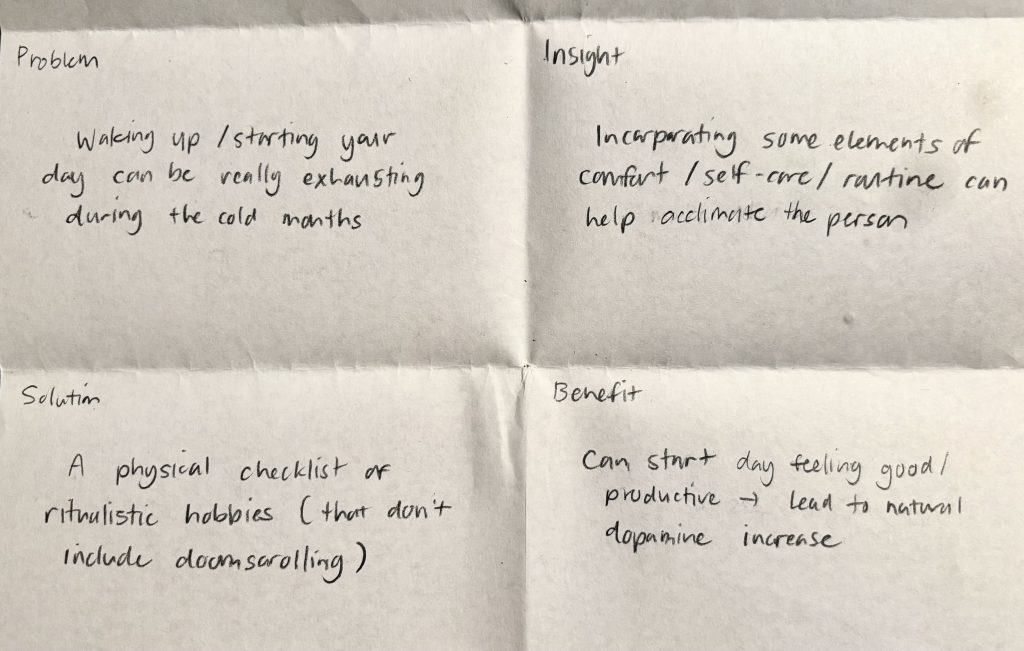Storyboarding – Jan 22, 2025
About the Assignment
This in-class assignment prompted us to identify an issue or problem that another person (a “client”) was experiencing and create potential solutions through one full round of the engineering design cycle process.
The Steps of the Design Cycle
1) Interviews and User Feedback
First, we got to know our user/client through an interview process. We asked what, how, and why questions to collect data about the problem they were experiencing and the context behind it.
My client’s issue was that they always start their day with very low energy. They would usually wake up and continue bedrotting while scrolling on their phone, and that would lower their energy even more, making it hard for them to be productive. Upon further questioning, I learned about the various reasons why they didn’t want to get out of bed. External conditions like temperature (how cold it is outside) played a role. Lack of intrinsic and extrinsic motivation was another.
2) Reframe the Problem
Next, we were asked to reframe the problem using the insight we gathered from the interview. Sometimes root cause of the problem was not the most obvious or the most intuitive answer. By reframing the problem, we were challenged to be open-minded in our approach to help our client.
Although the problem was initially identified as “having low energy on cold mornings”, I eventually reframed it to “not having a consistent, energetic morning ritual to get acclimated to waking up.”
3) Brainstorm Initial Solutions
Then we were asked to come up with various solutions using 4 different constraints. The first solution had to be intentionally expensive. The second was something that could be accomplished tomorrow (or in a short amount of time). The third needed to be a solution that already exists. Finally, the fourth had to involve robots.
The solutions I proposed were as follows:
- 1) Hire a motivational life coach to hold you accountable in the morning and prevent doom scrolling.
- 2) Design a morning ritual that is designed to give you energy and can be implemented tomorrow.
- 3) Download a productivity tracker app that locks all social media apps in the early morning to discourage phone time.
- 4) Build a robot alarm clock that will not fully turn off until you manually get out of bed to silence it.
4) Prototyping and Remixing
In this final phase, we received feedback from our client and used their constructive criticism to design a new and improved solution.
Some helpful feedback I received was:
- My client is a university student and does not have the luxury to afford to outsource labor for solutions #1 and #4.
- My client has tried a solution similar to solution #3 before. They have an iPhone and use the “Screen Time App Limits” feature to set time restrictions for apps like Instagram and TikTok. It doesn’t always work because the feature has an “Ignore” option once you reach your designated time limit.
- Solution #2 is the most practical and affordable, but my client had worries about how to go about implementing new habits and staying accountable.
The Final Storyboard
At the end of the design cycle, we created a storyboard summarizing the initial problem, the reframed problem, the solution, and the benefit to the solution.

If I were to add anything, I would specify that the ritual or the morning checklist should go from low energy items (such as sitting up and stretching) to high energy items (like cooking breakfast or taking a shower). This will allow the person to better acclimate to the routine in a way that feels natural to them.